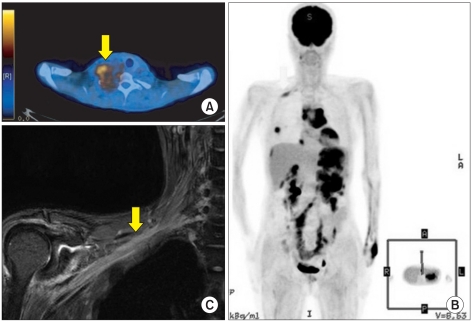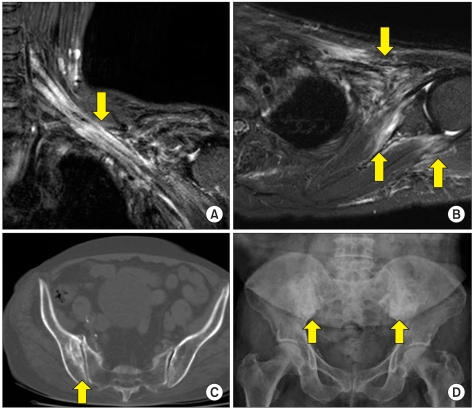Ann Rehabil Med.
2011 Dec;35(6):807-815. 10.5535/arm.2011.35.6.807.
Clinical, Electrophysiological Findings in Adult Patients with Non-traumatic Plexopathies
- Affiliations
-
- 1Department of Physical Medicine and Rehabilitation, Samsung Medical Center, Sungkyunkwan University School of Medicine, Seoul 135-710, Korea. yays.sung@samsung.com
- KMID: 2266806
- DOI: http://doi.org/10.5535/arm.2011.35.6.807
Abstract
OBJECTIVE
To ascertain the etiology of non-traumatic plexopathy and clarify the clinical, electrophysiological characteristics according to its etiology. METHOD: We performed a retrospective analysis of 63 non-traumatic plexopathy patients that had been diagnosed by nerve conduction studies (NCS) and needle electromyography (EMG). Clinical, electrophysiological, imaging findings were obtained from medical records.
RESULTS
We identified 36 cases with brachial plexopathy (BP) and 27 cases with lumbosacral plexopathy (LSP). The causes of plexopathy were neoplastic (36.1%), thoracic outlet syndrome (TOS) (25.0%), radiation induced (16.7%), neuralgic amyotrophy (8.3%), perioperative (5.6%), unknown (8.3%) in BP, while neoplastic (59.3%), radiation induced (22.2%), neuralgic amyotrophy (7.4%), psoas muscle abscess (3.7%), and unknown (7.4%) in LSP. In neoplastic plexopathy, pain presented as the first symptom in most patients (82.8%), with the lower trunk of the brachial plexus predominantly involved. In radiation induced plexopathy (RIP), pain was a common initial symptom, but the proportion was smaller (50%), and predominant involvements of bilateral lumbosacral plexus and whole trunk of brachial or lumbosacral plexus were characteristic. Myokymic discharges were noted in 41.7% patients with RIP. Abnormal NCS finding in the medial antebrachial cutaneous nerve was the most sensitive to diagnose TOS. Neuralgic amyotrophy of the brachial plexus showed upper trunk involvement in all cases.
CONCLUSION
By integrating anatomic, pathophysiologic knowledge with detailed clinical assessment and the results of ancillary studies, physicians can make an accurate diagnosis and prognosis.
Keyword
MeSH Terms
Figure
Reference
-
1. Dumitru D. Electrodiagnostic medicine. 2002. 2nd ed. Philadelphia: Hanley & Belfus;p. 785–814.2. Mumenthaler M. Some clinical aspects of peripheral nerve lesions. Eur Neurol. 1969; 2:257–268. PMID: 4309546.
Article3. Wilbourn AJ. Thonas PK, editor. Brachial plexus disorders. Peripheral neuropathy. 1993. 3rd ed. Philadelphia: WB Saunders;p. 911–950.4. Dumitru D. Electrodiagnostic medicine. 2002. 2nd ed. Philadelphia: Hanley & Belfus;p. 837–875.5. Das S, Ganju A, Tiel RL, Kline DG. Tumors of the brachial plexus. Neurosurg Focus. 2007; 22:E26. PMID: 17613218.
Article6. Ferrante MA. Brachial plexopathies: classification, causes, and consequences. Muscle Nerve. 2004; 30:547–568. PMID: 15452843.
Article7. Park JK. Samuels MA, Feske SK, editors. Peripheral nerve tumors. Office practice of neurology. 2003. 2nd ed. Philadelphia: Churchill Livingstone;p. 1118–1121.
Article8. Pacelli J, Whitaker CH. Brachial plexopathy due to malignant peripheral nerve sheath tumor in neurofibromatosis type 1: case report and subject review. Muscle Nerve. 2006; 33:697–700. PMID: 16323217.
Article9. Kamenova B, Braverman AS, Schwartz M, Sohn C, Lange C, Efiom-Ekaha D, Rotman M, Yoon H. Effective treatment of the brachial plexus syndrome in breast cancer patients by early detection and control of loco-regional metastases with radiation or systemic therapy. Int J Clin Oncol. 2009; 14:219–224. PMID: 19593613.
Article10. Kori SH, Foley KM, Posner JB. Brachial plexus lesions in patients with cancer: 100 cases. Neurology. 1981; 31:45–50. PMID: 6256684.11. Jaeckle KA, Young DF, Foley KM. The natural history of lumbosacral plexopathy in cancer. Neurology. 1985; 35:8–15. PMID: 2981417.
Article12. Briemberg HR, Amato AA. Neuromuscular complications of cancer. Neurol Clin. 2003; 21:141–165. PMID: 12690648.
Article13. Jaeckle KA. Neurologic manifestations of neoplastic and radiation-induced plexopathies. Semin Neurol. 2010; 30:254–262. PMID: 20577932.
Article14. Bruzzi JF, Komaki R, Walsh GL, Truong MT, Gladish GW, Munden RF, Erasmus JJ. Imaging of nonsmall cell lung cancer of the superior sulcus: part 1: anatomy, clinical manifestations, and management. Radiographics. 2008; 28:551–560. PMID: 18349457.15. Basso-Ricci S, della Costa C, Viganotti G, Ventafridda V, Zanolla R. Report on 42 cases of postirradiation lesions of the brachial plexus and their treatment. Tumori. 1980; 66:117–122. PMID: 7376261.
Article16. Mondrup K, Olsen NK, Pfeiffer P, Rose C. Clinical and electrodiagnostic findings in breast cancer patients with radiation-induced brachial plexus neuropathy. Acta Neurol Scand. 1990; 81:153–158. PMID: 2327236.
Article17. Olsen NK, Pfeiffer P, Johannsen L, Schroder H, Rose C. Radiation-induced brachial plexopathy: neurological follow-up in 161 recurrence-free breast cancer patients. Int J Radiat Oncol Biol Phys. 1993; 26:43–49. PMID: 8387067.
Article18. Harper CM Jr, Thomas JE, Cascino TL, Litchy WJ. Distinction between neoplastic and radiation-induced brachial plexopathy, with emphasis on the role of EMG. Neurology. 1989; 39:502–506. PMID: 2538777.19. Roth G, Magistris MR, Le Fort D, Desjacques P, Della Santa D. Post-radiation branchial plexopathy. Persistent conduction block. Myokymic discharges and cramps. Rev Neurol (Paris). 1988; 144:173–180. PMID: 3368692.20. Dumitru D. Electrodiagnostic medicine. 2002. 2nd ed. Philadelphia: Hanley & Belfus;p. 818–820.21. Plewa MC, Delinger M. The false-positive rate of thoracic outlet syndrome shoulder maneuvers in healthy subjects. Acad Emerg Med. 1998; 5:337–342. PMID: 9562199.
Article22. Kothari MJ, Macintosh K, Heistand M, Logigian EL. Medial antebrachial cutaneous sensory studies in the evaluation of neurogenic thoracic outlet syndrome. Muscle Nerve. 1998; 21:647–649. PMID: 9572246.
Article23. Levin KH, Wilbourn AJ, Maggiano HJ. Cervical rib and median sternotomy-related brachial plexopathies : a reassessment. Neurology. 1998; 50:1407–1413. PMID: 9595996.24. Machanic BI, Sanders RJ. Medial antebrachial cutaneous nerve measurements to diagnose neurogenic thoracic outlet syndrome. Ann Vasc Surg. 2008; 22:248–254. PMID: 18346579.
Article25. Seror P. Medial antebrachial cutaneous nerve conduction study, a new tool to demonstrate mild lower brachial plexus lesions. A report of 16 cases. Clin Neurophysiol. 2004; 115:2316–2322. PMID: 15351373.
Article26. Cooper DE, Jenkins RS, Bready L, Rockwood CA Jr. The prevention of injuries of the brachial plexus secondary to malposition of the patient during surgery. Clin Orthop Relat Res. 1988; 228:33–41. PMID: 3342585.
Article27. Kirsh MM, Magee KR, Gago O, Kahn DR, Sloan H. Brachial plexus injury following median sternotomy incision. Ann Thorac Surg. 1971; 11:315–319. PMID: 4927044.
Article28. van Alfen N. The neuralgic amyotrophy consultation. J Neurol. 2007; 254:695–704. PMID: 17446996.
Article29. Awerbuch GI, Nigro MA, Sandyk R, Levin JR. Relapsing lumbosacral plexus neuropathy. Report of two cases. Eur Neurol. 1991; 31:348–351. PMID: 1661676.30. Evans BA, Stevens JC, Dyck PJ. Lumbosacral plexus neuropathy. Neurology. 1981; 31:1327–1330. PMID: 6287351.
Article31. Sander JE, Sharp FR. Lumbosacral plexus neuritis. Neurology. 1981; 31:470–473. PMID: 7194440.
Article
- Full Text Links
- Actions
-
Cited
- CITED
-
- Close
- Share
- Similar articles
-
- The Video-Urodynamic and Electrophysiological Characteristics in Patients With Traumatic Spinal Cord Injury
- Sequential Changes and Prognostic Values of Electrophysiological Parameters in Guillain-Barre Syndrome
- Efficiency of the Boston Questionnaire in Carpal Tunnel Syndrome: Comparing Scores with Provocation Tests and Electrophysiological Studies
- Isolated Traumatic Ganglionic Hemorrhage
- Trans-Synaptic Degeneration of Peripheral Motor Axons from Metastatic Brain Tumors: Electrophysiological Findings in Two Cases



